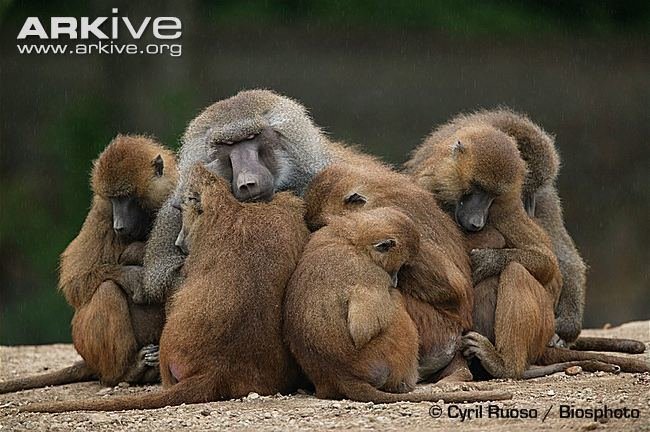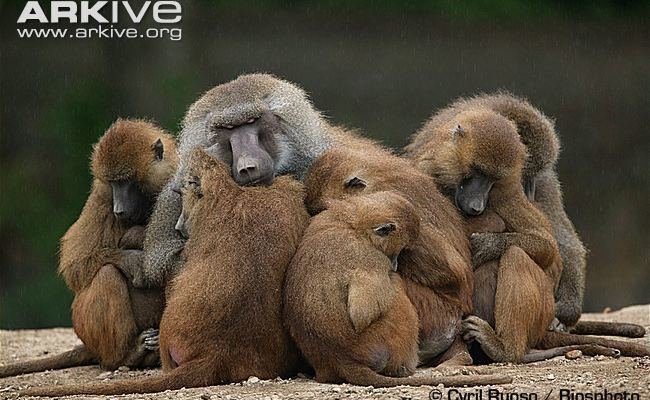
The guinea baboon (Papio papio) isn’t just another monkey swinging from branches; it’s a testament to evolutionary resilience. Much like how a great novel has complex characters that evolve over time, the guinea baboon’s lineage is packed with adaptations to environments, social structures, and behaviors that allow them to thrive. Let’s dive deep into their evolutionary past, exploring how they’ve become the fascinating animals we see today.
What Are Guinea Baboons?
Guinea baboons are medium-sized primates characterized by their distinctive looks and social behaviors. Weighing between 50 to 100 pounds, they’re not the largest of the baboon species, but their unique features set them apart. They have a short, stocky body, long limbs, and a pronounced muzzle with a flat face. These baboons are known for their thick fur, which varies in color from golden-brown to grayish tones, providing camouflage in their natural habitat.
These primates primarily inhabit the dry savannas and open woodlands of West Africa, ranging from Senegal to Guinea. Here’s the fascinating part: they have a social structure that’s highly developed and complex. Living in large groups called troops, they have clear hierarchies and social bonds, which are crucial for their survival. This social aspect is so vital that it’s akin to a tightly-knit community where everyone plays a role, from the leader to the caretakers of the young.
The Ancestry of Guinea Baboons
Understanding the evolutionary history of guinea baboons means going back several million years. They belong to the genus Papio, which emerged around 2 to 3 million years ago. Their ancestors were likely similar to modern baboons, adapted to a variety of habitats across Africa. As they evolved, various species branched off to fit specific environments, leading to the diverse baboon family we see today.
One key factor in their evolution was climate change. As Africa’s climate shifted, it shaped the habitats available to these primates. During periods of drought or changes in vegetation, guinea baboons had to adapt their diet and behavior to survive. These adaptations might have included becoming more omnivorous and relying on different food sources, allowing them to thrive in various environments.
So, when you look at a guinea baboon today, you’re not just seeing a cute animal; you’re witnessing millions of years of evolution shaped by the challenges of their environment.
Physical Adaptations of Guinea Baboons
The evolutionary journey of guinea baboons has also led to some remarkable physical adaptations. Their robust bodies and powerful limbs are designed for both ground and arboreal movement. Unlike some of their relatives that prefer to spend most of their time in trees, guinea baboons are more terrestrial and often forage on the ground. This adaptability allows them to cover greater distances in search of food, making them efficient foragers.
The unique coloration of their fur serves environmental purposes too. The shades of brown help them blend into the dry landscapes of West Africa, protecting them from potential predators. Their keen eyesight and acute sense of hearing are critical for detecting danger, allowing them to react swiftly when needed.
Additionally, their powerful jaws and sharp teeth are designed for a diverse diet that includes fruits, seeds, and even small animals. This ability to eat a wide range of foods has been a significant factor in their survival across different habitats, showing us just how adaptable these creatures are.
Social Structure and Behavior
Now, let’s talk about the social life of guinea baboons. Their troops can consist of up to 100 individuals, each with its own role and hierarchy. Social structures in baboon troops are fascinating and complex, often compared to a soap opera involving family dynamics, alliances, and rivalries.
In these groups, males usually leave their birth troop upon reaching maturity to join another troop, while females tend to stay for life. This behavior helps maintain genetic diversity while also fostering deep social bonds within the troop. The interactions between group members are crucial for their wellbeing. They groom each other not just for hygiene but also to strengthen friendships. It’s like a spa day for them—an opportunity to bond and socialize.
The vocalizations of guinea baboons are another intriguing aspect of their social behavior. They communicate through a variety of sounds, conveying warnings, calling to one another, or even expressing distress. This vocal communication is vital for coordinated actions, especially when it comes to foraging or avoiding predators. Honestly, if you were to sit quietly in the savanna, you’d feel as if you were part of an intricate conversation, where every sound plays its role in the larger story of the troop.
Diet and Foraging Strategies
The diet of guinea baboons reflects their adaptability and resourcefulness. Unlike some other primates, they have a varied diet that includes fruits, seeds, nuts, and even small animals. This omnivorous diet allows them to exploit various food sources depending on availability. Think of them as nature’s opportunists, always on the lookout for the next meal.
Foraging strategies vary based on the season and environment. During periods when fruits are plentiful, they shift their focus to ensuring they consume as much as possible. They’re known to travel long distances in search of food, sometimes covering several miles in a day. This behavior is not just about hunger; it’s about survival and ensuring the troop is well-nourished.
One interesting aspect of their foraging is their ability to work together. You might find them foraging in groups, using their social bonds to watch for potential dangers while they eat. It’s a great example of teamwork in the animal kingdom, where cooperation significantly increases their chances of survival.
Conservation Status and Threats
Unfortunately, guinea baboons face various threats that impact their populations. Habitat destruction due to human activities, such as agriculture and urbanization, poses significant risks to their natural environments. As we push further into their territories, these creatures find it increasingly challenging to find food and shelter.
Additionally, hunting remains a problem in some regions, as guinea baboons are sometimes seen as agricultural pests. This perspective can lead to conflicts between humans and these primates. It’s a harsh reality, but that’s where conservation efforts come in. Programs focused on protecting habitats and educating communities about the importance of guinea baboons are crucial for their survival.
As stewards of the environment, we play a role in the future of these animals. It’s important to raise awareness about the challenges they face and how we can contribute to their conservation. Supporting wildlife reserves and sustainable practices can make a difference, ensuring that future generations can appreciate the fascinating world of guinea baboons.
The Future of Guinea Baboons
So, what does the future hold for the guinea baboon? Their evolutionary history tells us a tale of resilience and adaptability. As they continue to navigate the challenges posed by a changing world, it’s up to us to ensure that they have a fighting chance.
Research into their behaviors and habitats can help inform conservation strategies, enabling us to create environments where they can thrive. Innovations in wildlife management and community engagement can foster a deeper understanding of these creatures and their role in the ecosystem.
Ultimately, the story of the guinea baboon is ongoing. With each new day, they continue to adapt and evolve, showcasing the remarkable capacity for survival in an ever-changing world. By appreciating their journey, we can help preserve these unique creatures for generations to come.
In conclusion, the evolutionary history of the guinea baboon is a captivating tale of adaptation, social complexity, and resilience. These animals remind us of the intricate connections in nature and the importance of protecting our shared planet. Let’s work together to ensure that their story continues!

